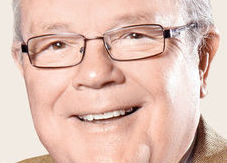By Peter Wagner
Smaller ads sold mostly to locally-owned businesses are a part of a community paper’s DNA. There weren’t any supermarkets, department stores or automobile dealerships when the majority of midwestern newspapers began publishing at the turn of the last century.
 I have a framed copy of the Jan. 1, 1873 Sheldon Mail hanging on the wall of my office. What is most surprising is the largest display ad in the now 145-year-old publication is a one column by 3.5 inches. More importantly, all the ads in that first edition wouldn’t fill a half of a broadsheet page today.
I have a framed copy of the Jan. 1, 1873 Sheldon Mail hanging on the wall of my office. What is most surprising is the largest display ad in the now 145-year-old publication is a one column by 3.5 inches. More importantly, all the ads in that first edition wouldn’t fill a half of a broadsheet page today.
When my wife and I put out our first publication, The Golden Shopper, our largest ad was a half-page on the front page. Most of the remaining pages were filled with 2 x 3, 2 x 5 and occasional quarter page ads. The nationally controlled firms all felt they had to advertise in the much older, more established newspaper.
We were thankful for those locally purchased small ads, however, and somehow we survived. In the boom times before corporate inserts, we regularly printed four-process color broadside pages for our local Hy-Vee grocery store. That too, disappeared, and we still survived.We were thankful for them when we had them, however, and we survived.
The truth is our publishing industry is changing in ways that is making it difficult to sustain and be profitable in both the paid circulation and free distribution publishing business.The same is true of most other forms of local business.
But, as long as papers have a commitment to providing solid local news and information to our community, newspapers and shoppers alike will find new opportunities to sell print advertising to an appreciative local market.
Communities now are a local supplier of professionally written and edited information. Study after study has concluded communities need a printed publication to flourish. Without a competent local paper, communities suffer the eventual loss of everything from main street retail synergy to in-town grade and high schools to much needed sales and property tax revenues.
A study by the North Carolina School of Media and Journalism found that more than 1,300 communities have completely lost their sources of local news.
The local printed paper must continue to exist and it can through persistence, creativity and a commitment of the local ownership.
Tell your story!
The secret of such success is “Telling your story!” For newspapers that means both sharing all the important local news of the community from the city chambers to the Little League as well as the advertising and marketing services the publication offers.
No business has ever succeeded in “saving itself out of financial difficulty.” Most successful business leaders turn a difficult corner by increasing the material and service delivered.
I was in Hawaii recently and saw an interesting large red poster in many windows on one island. It read: Here is what you did by buying from us …
- You contributed your dollars to local economy.
- You celebrated the unique buying opportunities of our community.
- You helped create local employment.
- You encouraged the building of a community.
- You kept important tax dollars at home.
- You benefited from our expertise.
- You invested in local enterprise.
- You made this community and all it offers a destination.
Everything promoted on that poster could also be said, with a bit of a twist in the wording, of the local paper. Our biggest failing as a publishing industry is we don’t tell our story strongly or often enough. If we don’t blow our own horn, who will?
Lifeblood of the community
Michael Bugeja, author of Interpersonal Divide in the Age of the Machine, recently wrote: “Don’t overlook newspapers. They are the lifeblood of the community. Subscribe to your hometown paper. Go farther and buy gift subscriptions for your relatives and friends. Discuss the news face to face at the dinner table instead of on Facebook.
“If you have children, let them see you pouring over the pages of the paper, pointing out stories about school, hobbies, and upcoming events you might attend. If you want to get rid of fake news, support your local newspaper. It takes a village to save a local newspaper. But saving a village is worth the price of a subscription.”
 Nevada Press Association The best in Nevada journalism since 1924
Nevada Press Association The best in Nevada journalism since 1924
